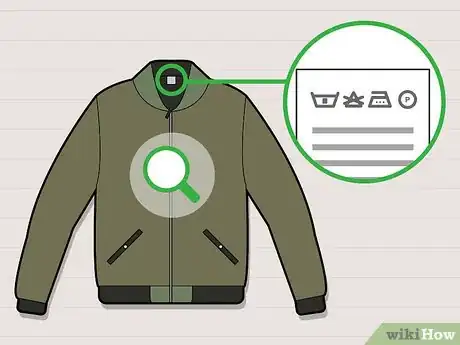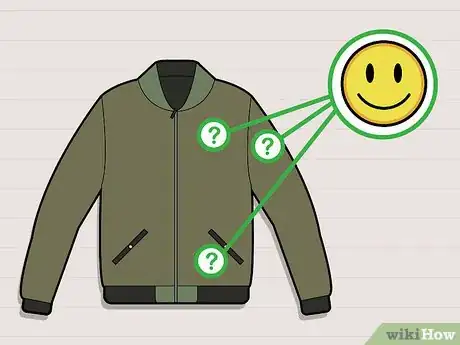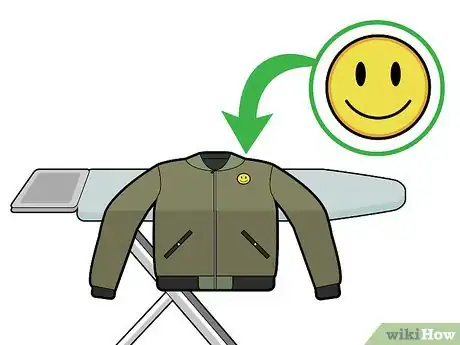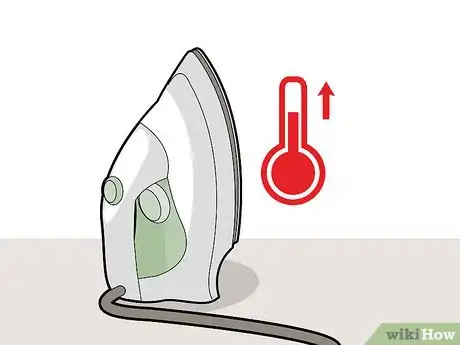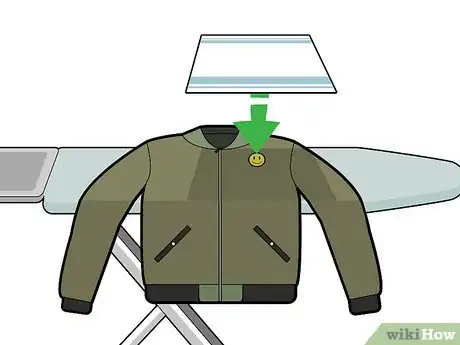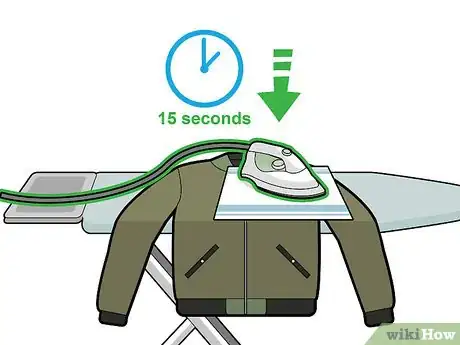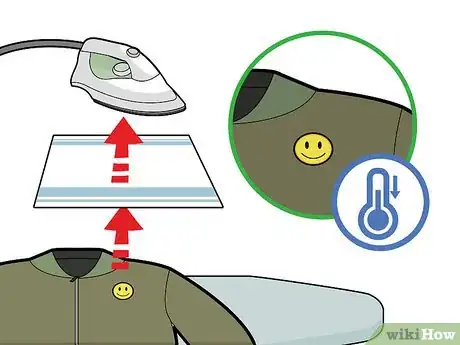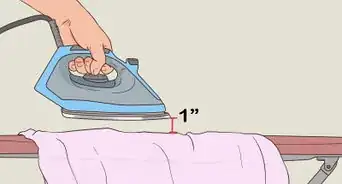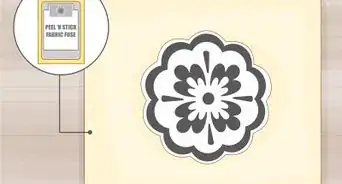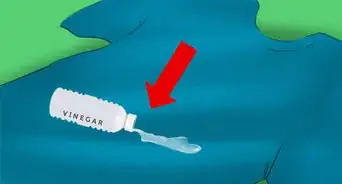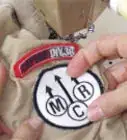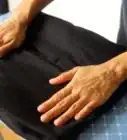wikiHow is a “wiki,” similar to Wikipedia, which means that many of our articles are co-written by multiple authors. To create this article, 13 people, some anonymous, worked to edit and improve it over time.
There are 7 references cited in this article, which can be found at the bottom of the page.
This article has been viewed 1,312,957 times.
Learn more...
Do you want want to proudly display your favorite bands on your jacket sleeve, or show off the skills you learned at summer camp on your backpack? Iron-on patches are a great way to express your individuality - and they're also useful for hiding damaged or torn spots on your clothes and accessories. Learn how to prepare fabric for a patch, iron it on, and make sure it stays in place after washing.
Steps
Preparing to Iron on a Patch
-
1Figure out what type of patch you have. Some patches come with glue on the back, and others simply have a cloth backing. Take a close look at your patch and decide whether you may need additional materials.
- Decorative embroidered fabric patches are usually thick, stiff, and have what looks like plastic glue on one side. These can be used to cover ripped or discolored fabric.
- Transfer paper patches are prints on one side of special paper, with a non-glossy paper side. These can't hold ripped fabric together and usually the fabric underneath will show through if it's not applied to something white.
- Patches that have a simple cloth backing can be attached using fusible web.
- Patches that are meant to cover up holes or stains and are designed to blend in with fabric often come with a paper backing that is pulled off before the patch is applied.
- Consider custom designing your own patch if you can't find one you like.
-
2Examine the fabric of your clothing or accessory. Fabrics like denim and cotton provide the best base for iron-on patches. As a general rule the fabric you choose should be at least as heavy as the patch.
- Look at the fabric care label to see whether it can be ironed (if not, there will be a crossed-out icon of an iron). If there's no label, try to figure out what material it's made of.
- Be very careful with polyester fabrics, since applying the high heat necessary for ironing on patches can burn the fabric or cause it to get discolored.[1]
- Silk and other delicate fabrics are not good candidates for patches.[2]
- Be very careful when you iron on chenille patches as the yarn is very sensitive to high temperatures.[3]
Advertisement -
3Think about design and placement. Before you heat up the iron, lay out your jacket, sash or backpack and decide where exactly you want the patch to be placed.
- If this is the only patch you intend to iron on this piece, put it in a tastefully prominent position. Make the placement look intentional.
- If you're planning on ironing on more patches, like you would for a girl scout's sash or any other type of collection, plan ahead to make sure there will be room for additional patches.
- If you are using a printable paper patch, remember that letters and other asymmetrical items will appear reversed.
Ironing on the Patch
-
1Lay the base item on a flat, heat-resistant surface. An ironing board is useful, but if you don't have one, you may also lay your item across a doubled-up bath towel on a sturdy table.[4]
- To ensure the item will provide a good surface for the patch, iron it first. If it's a backpack or another item that's difficult to iron, do your best to arrange it so that the part of the fabric that will be receiving the patch is flat against a hard surface.
-
2Place the patch in the position you chose. The adhesive side should be flat against the base fabric. Make sure that the patch isn't crooked.
- On embroidered patches, the adhesive side is the underside.
- On transfer paper patches, the adhesive side is the side where the image is printed. Place the image face down on the fabric. The paper backing will be peeled once the patch is ironed on.
- If you're using a fusible webbing, the fusible web backing should be against the fabric.
- If you're using a patch meant to blend in with fabric, you may need to apply it to the reverse side of the article of clothing. Follow the instructions that came with the packaging.
-
3Heat up an iron. Turn it to the hottest setting your fabric can tolerate. Make sure the "steam" option is turned off, and that your iron isn't full of water.[5]
-
4Place a thin towel over the patch. Take care not to disturb the position of the patch. The towel will protect the patch itself and the surrounding fabric.
-
5Position the heated iron over the patch and press down. Hold the iron there for about 15 seconds. Apply as much pressure as you can by pressing down firmly.
-
6Remove the iron and allow the patch to to cool. Lift the towel and check to see whether the patch is fixed on securely by gently rubbing at the edge with a finger, trying to lift it. If it lifts up a bit, replace the towel and press it with the iron again for 10 seconds.
- If you're working with a paper transfer patch, wait until it is fully cool (leave it for 10 minutes), then carefully peel off the paper.
Caring for Your Patch
-
1Consider sewing around the edges. For a completely secure patch, use a sewing machine or a needle and thread to secure the patch to the fabric. This greatly reduces the chances that the patch will fall off.[6]
- Choose a thread that matches the patch.
- Don't attempt to sew around the edge of printable paper patches.
- If your clothing has a hole and you want to cover it up with a patch, patches can be sewn in from the inside.
-
2Don't wash the article more than necessary. Iron-on patches are meant to be permanent, but they do become loosened over time. Take care not to let the article get too dirty, since washing it may cause the patch to start coming off.
- If you do need to wash the item, hand wash it using cold water. Allow it to air dry.
Community Q&A
-
QuestionCan you put iron on patches in the wash?
 wikiHow Staff EditorThis answer was written by one of our trained team of researchers who validated it for accuracy and comprehensiveness.
wikiHow Staff EditorThis answer was written by one of our trained team of researchers who validated it for accuracy and comprehensiveness.
Staff Answer wikiHow Staff EditorStaff AnswerWhile you can wash items that have iron-on patches properly attached, care must be taken. Only wash in cold to lukewarm water and where possible, hand wash the item. If washing in the machine, only use the gentle cycle. Always turn the garment with the iron-on patch inside out when washing it. Try to keep washing to a minimum, to preserve the patch and if its edges fray a lot, you may need to trim them or even stitch them back down. It is also a good idea to read the iron-on patch manufacturer’s instructions regarding washing, as this may vary from brand to brand.
wikiHow Staff EditorStaff AnswerWhile you can wash items that have iron-on patches properly attached, care must be taken. Only wash in cold to lukewarm water and where possible, hand wash the item. If washing in the machine, only use the gentle cycle. Always turn the garment with the iron-on patch inside out when washing it. Try to keep washing to a minimum, to preserve the patch and if its edges fray a lot, you may need to trim them or even stitch them back down. It is also a good idea to read the iron-on patch manufacturer’s instructions regarding washing, as this may vary from brand to brand. -
QuestionCan I iron a patch onto a luggage case?
 wikiHow Staff EditorThis answer was written by one of our trained team of researchers who validated it for accuracy and comprehensiveness.
wikiHow Staff EditorThis answer was written by one of our trained team of researchers who validated it for accuracy and comprehensiveness.
Staff Answer wikiHow Staff EditorStaff AnswerPatches can be added to luggage cases but whether or not it can be ironed in place depends on the material from which the luggage case is made. Fabric luggage cases should be fine for ironing on patches. However, leather baggage cases will require the patches to be sewn or glued on, as heat should not be applied to leather. For synthetic cases (rayon, nylon, etc.), heat will usually cause the material to melt, so it is not advised to iron on patches to such luggage. Always check the material on the case with its ironing suitability before deciding what to do.
wikiHow Staff EditorStaff AnswerPatches can be added to luggage cases but whether or not it can be ironed in place depends on the material from which the luggage case is made. Fabric luggage cases should be fine for ironing on patches. However, leather baggage cases will require the patches to be sewn or glued on, as heat should not be applied to leather. For synthetic cases (rayon, nylon, etc.), heat will usually cause the material to melt, so it is not advised to iron on patches to such luggage. Always check the material on the case with its ironing suitability before deciding what to do. -
QuestionCan you use a hair straightener to iron on a patch?
 wikiHow Staff EditorThis answer was written by one of our trained team of researchers who validated it for accuracy and comprehensiveness.
wikiHow Staff EditorThis answer was written by one of our trained team of researchers who validated it for accuracy and comprehensiveness.
Staff Answer wikiHow Staff EditorStaff AnswerYou can use a hair straightener to seal an iron-on patch; it’s usually easier and faster than using a standard iron. You’ll need to warm it up first, position the iron patch where you want it, then clamp the warmed hair straightener over the patch on the fabric. Hold in place for about 30 to 60 seconds. Since the hair straightener is unlikely to be wide enough for all of the patch, you’ll need to move it around until all is sealed onto the fabric, each time holding the hair straightener in position for 30 to 60 seconds. If you’re concerned about the patch glue getting onto the hair straightener, fold foil around the straightener sides before heating, and remove when cooled down after use.
wikiHow Staff EditorStaff AnswerYou can use a hair straightener to seal an iron-on patch; it’s usually easier and faster than using a standard iron. You’ll need to warm it up first, position the iron patch where you want it, then clamp the warmed hair straightener over the patch on the fabric. Hold in place for about 30 to 60 seconds. Since the hair straightener is unlikely to be wide enough for all of the patch, you’ll need to move it around until all is sealed onto the fabric, each time holding the hair straightener in position for 30 to 60 seconds. If you’re concerned about the patch glue getting onto the hair straightener, fold foil around the straightener sides before heating, and remove when cooled down after use.
References
- ↑ https://www.thriftyfun.com/Removing-Shiny-Iron-Marks-on-Polyester-Clothing.html
- ↑ http://suessparklers.com/blog/how-to-apply-iron-on-designs
- ↑ https://www.ultrapatches.com/blog/how-to-iron-on-chenille-patches/
- ↑ https://www.liveabout.com/iron-on-a-patch-1106106
- ↑ https://www.soccerhelp.com/soccershop/how-to-iron-on-patches
- ↑ https://sewguide.com/how-to-sew-clothing-patches/
- http://1ferretstreasures.com/application-instructions/
About This Article
To iron on a patch, start by laying the item that you’re attaching it to on a flat, heat-resistant surface, like an ironing board. Next, position the patch where you’d like it to stick and heat your iron to its highest setting. Then, place a thin towel over the patch to protect it, as well as the surrounding fabric. Once the iron is hot, position it over the patch and press it down firmly for 15 seconds. Finally, remove the iron and the towel and allow the patch to cool completely. For tips on how to wash an item with ironed-on patches, read on!

